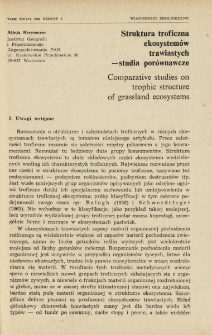- Wyszukaj w całym Repozytorium
- Piśmiennictwo i mapy
- Archeologia
- Baza Młynów
- Nauki przyrodnicze
Wyszukiwanie zaawansowane
Wyszukiwanie zaawansowane
Wyszukiwanie zaawansowane
Wyszukiwanie zaawansowane
Wyszukiwanie zaawansowane

Obiekt
Tytuł: Struktura troficzna ekosystemów trawiastych - studia porównawcze
Inny tytuł:
Comparative studies on trophic structure of grassland ecosystems
Współtwórca:
Polska Akademia Nauk. Komitet Ekologiczny
Wydawca:
Miejsce wydania:
Opis:
Strony 115-147 ; 24 cm ; Bibliografia na stronach 143-146 ; Streszczenie w języku angielskim
Typ obiektu:
Niepewność położenia w metrach:
grassland ecosystems ; food chains (ecology)
Abstrakt:
This is a review and analysis of the latest ecological works on the trophic structure of grassland ecosystems. The analysis has been made as follows: (1) Introduction to the topic and definitions of basic terms used, (2) Autotrophs— vascular plants in grassland ecosystems, this including (2.1.) Production, (2.2.) P/B index, (2.3.) Vertical distribution of organic matter. The series of measurements of productivity of grassland ecosystems are compared (Table I) showing great similarity on the large areas of North America and Soviet Union. The difference between the highest and the lowest primary production is about ten-fold. The relationship between the above-ground plant production and the precipitation (Fig. 1) looks quite distinct. The prevalence of underground organic matter over the green one increases with the decreasing amount of water available in the environment (Figs. 2, 3, Table II). Grassland ecosystems have a very high P/B index which proves their high production efficiency as compared with other terrestrial ecosystems. (3). Heterotrophs — their ecological characteristics and role in matter cycling in the ecosystem. Distinct conditioning of trophic structure by ecosystem utilization, e.g., grazing, mowing is shown (Fig. 4). As a result of grazing in the grassland ecosystems a trophic chain of coprophagous forms is developed (Fig. 5). An analysis of the biomass distribution of various invertebrate consumers shows that the absolute prevalence is obtained usually by soil fauna, consisting mainly of saprophages (Table III). As regards bioenergetics characteristics, consumers of grassland ecosystems show a great variety (Fig. 6, analyses of indices A/C, P/A, R/A, in the paper). But always the expenditure of energy on living costs distinctly exceeds that on production of body tissues. (4) Trophic pyramids in grassland ecosystems and (5) Quantitative relations among trophic levels. On the basis of American (Fig. 7) and French literature (Fig. 8) trophic pyramids of different grassland ecosystem types are discussed and then the quantitative relations among trophic levels are calculated (Tables IV—VI). It has been found that even several thousands (2000—3000) units of heterotrophe biomass fall per a unit of autotrophe biomass — as it happens in ecosystems under bad, extreme abiotic conditions. Whereas it is 70—300 in ecosystems of temperate zones. The biomass ratio for levels of consecutive consumers (phytophages/predators) ranges from 2 to 18 and thus is several rows lower. The last chapter „Remarks on the strategy of grassland ecosystems” is a discussion of various possible ways of evolution of grassland ecosystems.
Czasopismo/Seria/cykl:
Tom:
Zeszyt:
Strona pocz.:
Strona końc.:
Szczegółowy typ zasobu:
Identyfikator zasobu:
oai:rcin.org.pl:204587 ; ISSN 0013-2969
Źródło:
MiIZ PAN, sygn. P.3259 ; kliknij tutaj, żeby przejść
Język:
Język streszczenia:
Prawa:
Licencja Creative Commons Uznanie autorstwa 3.0 Polska
Zasady wykorzystania:
Zasób chroniony prawem autorskim. [CC BY 3.0 PL] Korzystanie dozwolone zgodnie z licencją Creative Commons Uznanie autorstwa 3.0 Polska, której pełne postanowienia dostępne są pod adresem: ; -
Digitalizacja:
Muzeum i Instytut Zoologii Polskiej Akademii Nauk
Lokalizacja oryginału:
Biblioteka Muzeum i Instytutu Zoologii PAN
Dofinansowane ze środków:
Dostęp:
Kolekcje, do których przypisany jest obiekt:
- Repozytorium Cyfrowe Instytutów Naukowych > Kolekcje Partnerów > Muzeum i Instytut Zoologii PAN > Czasopisma
- Repozytorium Cyfrowe Instytutów Naukowych > Piśmiennictwo > Czasopisma/Artykuły
Data ostatniej modyfikacji:
4 lut 2025
Data dodania obiektu:
9 sie 2021
Liczba pobrań / odtworzeń:
80
Wszystkie dostępne wersje tego obiektu:
https://rcin.org.pl./publication/144353
Wyświetl opis w formacie RDF:
Wyświetl opis w formacie RDFa:
Wyświetl opis w formacie OAI-PMH:
| Nazwa wydania | Data |
|---|---|
| Z. 2. Struktura troficzna ekosystemów trawiastych - studia porównawcze / Breymeyer A. | 4 lut 2025 |
Obiekty Podobne
Breymeyer, Alicja I.
Banach, Anna Kozakiewicz, Anna Kozakiewicz, Michał Liro, Anna
Rybak, Jan Igor
Stańczykowska, Anna
Gliwicz, Zbigniew Maciej
Stańczykowska, Anna

 INSTYTUT ARCHEOLOGII I ETNOLOGII POLSKIEJ AKADEMII NAUK
INSTYTUT ARCHEOLOGII I ETNOLOGII POLSKIEJ AKADEMII NAUK
 INSTYTUT BADAŃ LITERACKICH POLSKIEJ AKADEMII NAUK
INSTYTUT BADAŃ LITERACKICH POLSKIEJ AKADEMII NAUK
 INSTYTUT BADAWCZY LEŚNICTWA
INSTYTUT BADAWCZY LEŚNICTWA
 INSTYTUT BIOLOGII DOŚWIADCZALNEJ IM. MARCELEGO NENCKIEGO POLSKIEJ AKADEMII NAUK
INSTYTUT BIOLOGII DOŚWIADCZALNEJ IM. MARCELEGO NENCKIEGO POLSKIEJ AKADEMII NAUK
 INSTYTUT BIOLOGII SSAKÓW POLSKIEJ AKADEMII NAUK
INSTYTUT BIOLOGII SSAKÓW POLSKIEJ AKADEMII NAUK
 INSTYTUT CHEMII FIZYCZNEJ PAN
INSTYTUT CHEMII FIZYCZNEJ PAN
 INSTYTUT CHEMII ORGANICZNEJ PAN
INSTYTUT CHEMII ORGANICZNEJ PAN
 INSTYTUT FILOZOFII I SOCJOLOGII PAN
INSTYTUT FILOZOFII I SOCJOLOGII PAN
 INSTYTUT GEOGRAFII I PRZESTRZENNEGO ZAGOSPODAROWANIA PAN
INSTYTUT GEOGRAFII I PRZESTRZENNEGO ZAGOSPODAROWANIA PAN
 INSTYTUT HISTORII im. TADEUSZA MANTEUFFLA POLSKIEJ AKADEMII NAUK
INSTYTUT HISTORII im. TADEUSZA MANTEUFFLA POLSKIEJ AKADEMII NAUK
 INSTYTUT JĘZYKA POLSKIEGO POLSKIEJ AKADEMII NAUK
INSTYTUT JĘZYKA POLSKIEGO POLSKIEJ AKADEMII NAUK
 INSTYTUT MATEMATYCZNY PAN
INSTYTUT MATEMATYCZNY PAN
 INSTYTUT MEDYCYNY DOŚWIADCZALNEJ I KLINICZNEJ IM.MIROSŁAWA MOSSAKOWSKIEGO POLSKIEJ AKADEMII NAUK
INSTYTUT MEDYCYNY DOŚWIADCZALNEJ I KLINICZNEJ IM.MIROSŁAWA MOSSAKOWSKIEGO POLSKIEJ AKADEMII NAUK
 INSTYTUT PODSTAWOWYCH PROBLEMÓW TECHNIKI PAN
INSTYTUT PODSTAWOWYCH PROBLEMÓW TECHNIKI PAN
 INSTYTUT SLAWISTYKI PAN
INSTYTUT SLAWISTYKI PAN
 SIEĆ BADAWCZA ŁUKASIEWICZ - INSTYTUT TECHNOLOGII MATERIAŁÓW ELEKTRONICZNYCH
SIEĆ BADAWCZA ŁUKASIEWICZ - INSTYTUT TECHNOLOGII MATERIAŁÓW ELEKTRONICZNYCH
 MUZEUM I INSTYTUT ZOOLOGII POLSKIEJ AKADEMII NAUK
MUZEUM I INSTYTUT ZOOLOGII POLSKIEJ AKADEMII NAUK
 INSTYTUT BADAŃ SYSTEMOWYCH PAN
INSTYTUT BADAŃ SYSTEMOWYCH PAN
 INSTYTUT BOTANIKI IM. WŁADYSŁAWA SZAFERA POLSKIEJ AKADEMII NAUK
INSTYTUT BOTANIKI IM. WŁADYSŁAWA SZAFERA POLSKIEJ AKADEMII NAUK




































